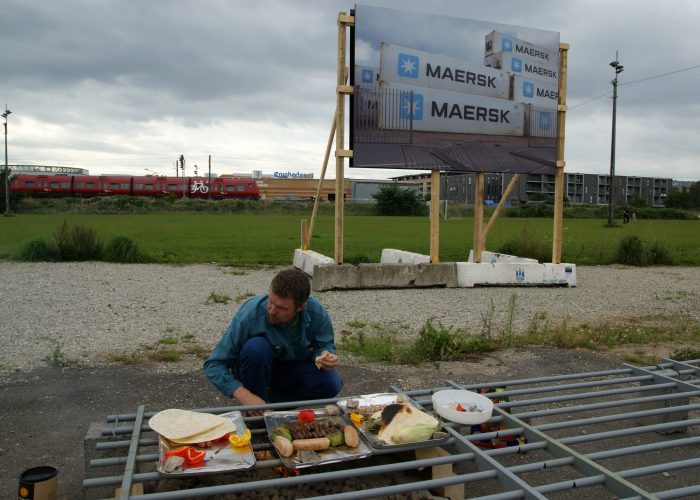A project in public space in Copenhagen by Oliver Ressler
2011
The project Resist to Exist consists of two elements, which are presented next to each other within sight of the S-train station Bispebjerg in Copenhagen.


The first element of the intervention is a freestanding billboard of 366 x 244 cm that shows a photographic image with fenced-in containers of the shipping and oil conglomerate Maersk – the largest Danish corporation and the world’s largest container-shipping corporation. Containers are the most important means of transportation for goods around the globe and therefore essential for the continuation of capitalist world-market. Major parts of the fence on the image are destroyed, as if they were taken down in an uprising.

This billboard is accompanied by 12 meters of fence placed next to the billboard. It appears to be pieces from the extracted fence on the billboard. Concrete panels are beneath the fence, so that it is slightly above the ground. This metal structure can be used as a grill for a huge barbecue freely available to the public. The fence, which previously formed a barrier between a transnational corporation and the public, has been transformed into a “commons” – into something joyful, practical and meaningful where people can meet. It creates an image for the dispossession of the “republic of property” through the “multitude of the poor” that emerges “at the center of the project for revolutionary transformation”[1].
According to the social theorist David Harvey, the main achievement of neo-liberalization has been to redistribute, rather than generate, wealth and income. In this “accumulation by dispossession”, existing wealth is extracted by transnational corporations from areas all around the world, usually from the poor or the public sector, through legal or illegal means, and most often in situations where the limits of legality are unclear.[2] The billboard imagines the reclaiming of this previously expropriated wealth, the attempt of the people to win it back.

The project Resist to Exist is a re-appropriation of activities that protagonists of social movements such as the Piqueteros, practiced in the uprising during the crisis in Argentina in 2001. For them, destroying fences and re-using them as tools to prepare a meal, became an act of survival. In order to exist, boundaries between what appeared to be immovable were dismantled. The project in Copenhagen takes place in an old railroad area, which residents from 2002 to 2007 tried to transform into a park (with barbecue areas) and cultural facilities according to their needs. The municipal officials finally forced out the residents. The project is also within view of the Føtex shopping center, one of many subsidiaries of Maersk.

Resist to Exist pursues the question whether an activist practice – which was performed in a specific historical situation – can gain a new relevance in this current situation, where not a single state, but the capitalist system as a whole is in crisis. The project opened with a free barbecue for everyone July 30, 2011 and remained in place until August 21, 2011. During this period, it was open to everyone to use for meetings and barbecues at any time.
The project was done during a residency at ANA – Astrid Noack’s Atelier (www.astrid-noack.dk) in Copenhagen in July 2011, supported by Statens Kunstråd, Nørrebro Lokaludvalg and BM:UKK.
Credits: Kirsten Dufour (ANA, YNKB), Katrine Skovgaard (ANA), Biba Fibiger, Inger Kærgaard, Andreas Lykke Jensen, John Jordan, Bjørn O., Katarzyna Winiecka.
[1] Antonio Negri and Michael Hardt: Commonwealth, Cambridge, 2009, p. 55
[2] Ibid., p. 230 – 231











